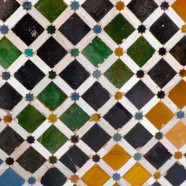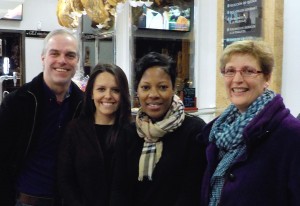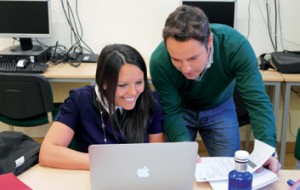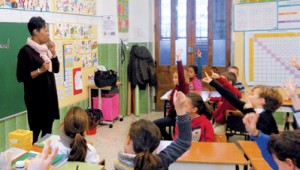
This past fall, four Lower School faculty visited classrooms and children whom they’d only met over Skype. The Milton teachers spent six days in Spain, eager participants in the activities of Colegio del Pilar, a K–12 school in Madrid, and longtime exchange partner for Milton’s Upper School Spanish students. They were excited to explore possibilities for expanding the connections between Milton’s Lower School and El Pilar’s youngest learners, now that Milton is teaching Spanish in the elementary grades. El Pilar’s service-learning program was of particular interest to Milton faculty, as was visiting the Alhambra in Granada. The visit directly enriched their own teaching about language, history, art and culture. This real-time, on-the-ground curriculum innovation was funded by the Betty Buck Teaching Chair, which supports faculty in creative curriculum development. The faculty share here a mini-blog: moments and images that were highlights of their adventure.
Our Grade 2 students have an interdisciplinary unit on Japan. I introduce our students to Japanese brush painting, beginning with pictures of bamboo. I planned to teach this art form to second graders at El Pilar as well. I was nervous about my Spanish communication skills, but before our trip, Luis — who teaches in the bilingual program at El Pilar — assured me that the students would understand me very well.
I went into class with 30 bamboo brushes, Japanese rice paper, and a few photos of the Asian college student who taught me brush painting years ago. (El Pilar teachers provided sumi ink, relieving my fears of it spilling in my suitcase!) I taught Luis’s class the first morning we arrived and, sure enough, the students understood me very well. The universal language of art helped me where words failed. From the students’ smiling, happy faces, and beautiful bamboo paintings, I knew we had made a connection.
Sandy Butler, Lower School Art
 I had the profound opportunity to introduce three of my colleagues to my home country. I am from Madrid, and at El Pilar I shared what growing up in Spain was like for me — how I experienced education. The trip was full of proud and nostalgic moments — sharing my culture, and my favorite foods, shopping destinations, sights to see. There are many similarities and many differences between the two cultures. Reflecting on my childhood experience — and how it contrasts with my teaching practice in the United States — I try to draw on the best of both cultures in my classroom.
I had the profound opportunity to introduce three of my colleagues to my home country. I am from Madrid, and at El Pilar I shared what growing up in Spain was like for me — how I experienced education. The trip was full of proud and nostalgic moments — sharing my culture, and my favorite foods, shopping destinations, sights to see. There are many similarities and many differences between the two cultures. Reflecting on my childhood experience — and how it contrasts with my teaching practice in the United States — I try to draw on the best of both cultures in my classroom.
One familiar comfort I had been craving was the Spanish cuisine! When we landed at Barajas Airport in Madrid, we grabbed breakfast, and I advised my colleagues to start their culinary journey sampling bocadillos — sandwiches of Spain. They enjoyed the tortilla de patata and Jamon Iberico, as did I!
Lucia Castineira, Lower School Spanish
On our first day, we toured El Pilar while school was in session. Through hallways richly decorated with marble and stained glass, we could see and hear children playing. As we walked out into a large courtyard filled with students at morning recess, the second graders ran over and swarmed us with hugs, yelling, “Hola, Tasha! Hola, Lucia!” They recognized us from our many Skype sessions that connected them with our Grade 2 students during Spanish class. At that moment I thought, “How wonderful, to know one another from that distant communication and now be face to face.” Being in such a beautiful place, welcomed and embraced by these amazing children, was a great feeling.
Tasha Summers, Grade 2
 The Alhambra. Here were the walls covered in geometric tile decorations that had inspired M. C. Escher to create his mathematical tessellations; like almost everyone of a certain age, I had an Escher poster on my dorm room wall in college. Looking up, ceilings filled with muqarnas, the almost organic honeycombed “stalactites” unique to Islamic architecture. And then, the Court of the Lions: “no part of the edifice gives a more complete idea of its original beauty than this…” wrote Washington Irving almost two hundred years ago. His words hold true today. Turning a corner, I entered an Islamic representation of Paradise rendered in architecture. Open to the elements, a double row of slender columns topped with elaborately carved stucco patterns surrounds the famous Lion Fountain within. Twelve lions, calmly spewing forth water for the last thousand years, carved by Christians, originally in the home of a Jewish vizier, in the heart of an Islamic palace: a beautiful, physical manifestation of the interplay between the three religious faiths we study in Grade 4.
The Alhambra. Here were the walls covered in geometric tile decorations that had inspired M. C. Escher to create his mathematical tessellations; like almost everyone of a certain age, I had an Escher poster on my dorm room wall in college. Looking up, ceilings filled with muqarnas, the almost organic honeycombed “stalactites” unique to Islamic architecture. And then, the Court of the Lions: “no part of the edifice gives a more complete idea of its original beauty than this…” wrote Washington Irving almost two hundred years ago. His words hold true today. Turning a corner, I entered an Islamic representation of Paradise rendered in architecture. Open to the elements, a double row of slender columns topped with elaborately carved stucco patterns surrounds the famous Lion Fountain within. Twelve lions, calmly spewing forth water for the last thousand years, carved by Christians, originally in the home of a Jewish vizier, in the heart of an Islamic palace: a beautiful, physical manifestation of the interplay between the three religious faiths we study in Grade 4.
Randy Schmidt, Grade 4



